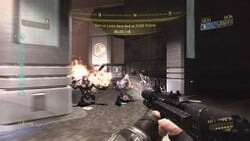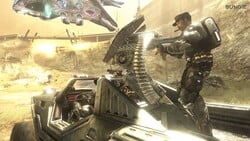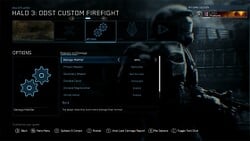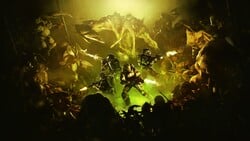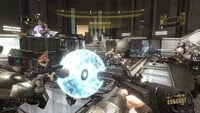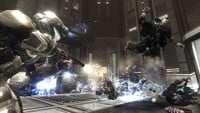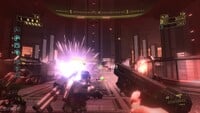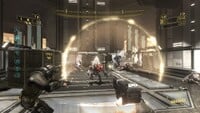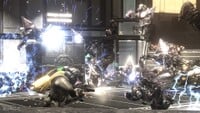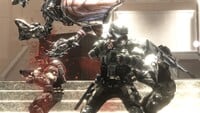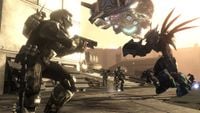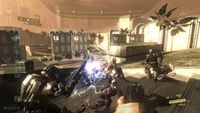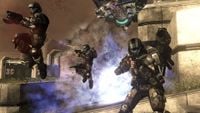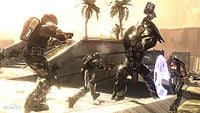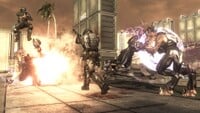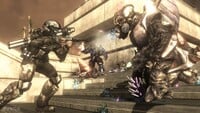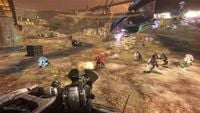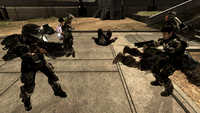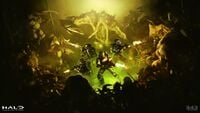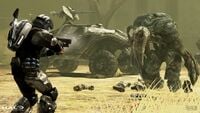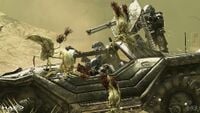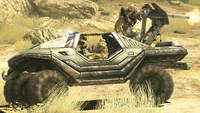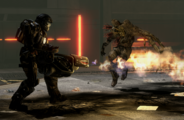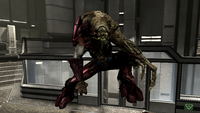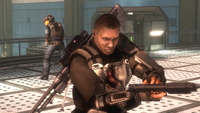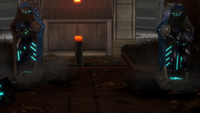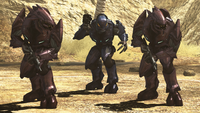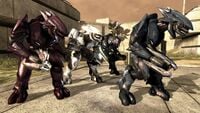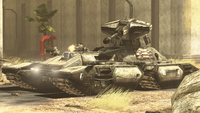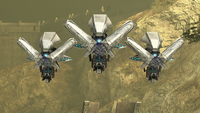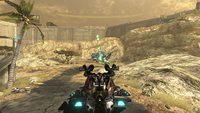Firefight (Halo 3: ODST)
From Halopedia, the Halo wiki
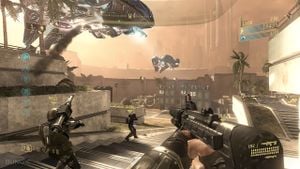
- "Built on top of Halo 3: ODST's campaign, Firefight is a cooperative game mode that lets you and up to three of your friends put your skills to the ultimate test. It allows you to jump straight into the heart of Halo and experience traditional Halo sandbox encounters with a new, high octane twist. Though you’ve squared off against most of the enemies you’ll face in Firefight before, you’re not going to be able to rely on your past experiences alone to guide you through all of the action. In Firefight, even the most "harmless" enemy can become a dangerous threat when you’re low on ammo, low on lives, and have your back against the wall. Throw game play modifying skulls into the mix and you'll find that the combat can become even more interesting and intense."
- — Bungie.net description[1]
Firefight is a game mode that debuted in Halo 3: ODST, and has since become a staple gamemode across the Halo series.[2]
Overview[edit]
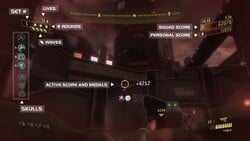
- "Problem is, we got alien bastards in the house. Each new wave means more bad guys. Five waves make up a round. Three rounds in a set. Sounds easy, huh? Wrong! See these skulls? When they activate, they turn a casual Covenant make-out session into a full-on test of your manly prowess!"
- — Sgt. Johnson[3]
Firefight is an endless wave-based survival mode introduced in Halo 3: ODST to supplement regular competitive multiplayer matchmaking. Players compete to survive waves of Covenant troops deployed by Phantom dropships for as long as possible, earning points and attempting to survive as long as possible. The mode supports up to four players in splitscreen or Xbox LIVE cooperative play. Players have a limited number of lives - meaning the game only ends when all players are dead. Firefight can be played on Easy, Normal, Heroic and Legendary difficulties, and players can optionally enable the Blind, Cowbell, IWHBYD and Grunt Birthday skulls for no increase in score.[1]
Firefight is structured into waves, rounds and sets. A wave consists of a handful of enemy infantry deploying from one or two dropships or doorways onto the level at a time. Five waves make up a round and three rounds make up a set. At the end of every round, players are restored lives, weapons and vehicles. As a set progresses, a new skull will be enabled for each round, though these skulls will reset at the end of the set. Meanwhile, at the end of every set, an additional skull is enabled permanently, making the experience harder and harder. As the waves in a given round and rounds in a given set increase, the enemies deployed onto the battlefield will get harder, progressing from Grunts and Jackals to Brutes and Hunters - ending the round with Brute Chieftains. No matter what difficulty is selected for Firefight, the Tough Luck skull is always enabled.[1]
At the end of each set is a bonus round. During the short bonus round, a single Phantom will hover over the battlefield and disperse an endless wave of Grunts for players to kill for points and score. During the bonus round, all skulls are enabled including Iron, meaning that if a player dies they will be unable to respawn until the round is complete. However, player deaths in the bonus round do not subtract from the overall pool of lives.[4] If players score high enough during the bonus round, they are awarded bonus lives.
Skulls[edit]
The following is a summary of the skulls featured in Halo 3: ODST's Firefight. Some skulls can be activated before setting up the match, for no change in score, namely: Blind, Cowbell, Grunt Birthday Party and IWHBYD. Most, however, are activated progressively throughout the match, as outlined below. The only Halo 3: ODST skull which does not feature in Firefight is Thunderstorm.
Standard Skulls[edit]
| Set | Round | Set skulls | Round skulls |
|---|---|---|---|
| 1 | 1 | N/A | Tough Luck |
| 2 | Tough Luck, Catch | ||
| 3 | Tough Luck, Catch, Black Eye | ||
| Bonus | Tilt, Famine, Mythic | Tough Luck, Catch, Black Eye, Iron | |
| 2 | 1 | Tilt | Tough Luck |
| 2 | Tough Luck, Catch | ||
| 3 | Tough Luck, Catch, Black Eye | ||
| Bonus | Tilt, Famine, Mythic | Tough Luck, Catch, Black Eye, Iron | |
| 3 | 1 | Tilt, Famine | Tough Luck |
| 2 | Tough Luck, Catch | ||
| 3 | Tough Luck, Catch, Black Eye | ||
| Bonus | Tilt, Famine, Mythic | Tough Luck, Catch, Black Eye, Iron | |
| 4 and above | 1 | Tilt, Famine, Mythic | Tough Luck |
| 2 | Tough Luck, Catch | ||
| 3 | Tough Luck, Catch, Black Eye | ||
| Bonus | Tough Luck, Catch, Black Eye, Iron |
Floodfight Skulls[edit]
In the April 2022 update for Halo: The Master Chief Collection, a new mode was implemented into Halo 3: ODST Firefight known as Floodfight (see below for details). The Floodfight update included a Seasonal Challenge called Gravetender, which effectively served as a Floodfight equivalent to the Endure achievement/challenge in regular Firefight. Only one set is available in Floodfight.
| Set | Round | Set skulls | Round skulls |
|---|---|---|---|
| 1 | 1 | N/A | Tough Luck |
| 2 | Tough Luck, Famine | ||
| 3 | Tough Luck, Famine, Tilt | ||
| Bonus | Famine, Mythic | Tough Luck, Black Eye, Iron | |
| 2 | 1 | Tilt | Tough Luck |
| 2 | Tough Luck, Catch | ||
| 3 | Tough Luck, Catch, Black Eye | ||
| Bonus | Tilt, Famine, Mythic | Tough Luck, Catch, Black Eye, Iron | |
| 3 | 1 | Tilt, Famine | Tough Luck |
| 2 | Tough Luck, Catch | ||
| 3 | Tough Luck, Catch, Black Eye | ||
| Bonus | Tilt, Famine, Mythic | Tough Luck, Catch, Black Eye, Iron | |
| 4 and above | 1 | Tilt, Famine, Mythic | Tough Luck |
| 2 | Tough Luck, Catch | ||
| 3 | Tough Luck, Catch, Black Eye | ||
| Bonus | Tough Luck, Catch, Black Eye, Iron |
Player characters[edit]
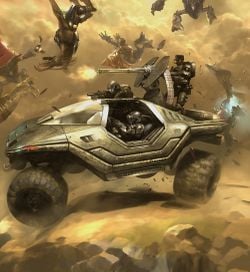
- Main article: Armor customization (Halo 3: ODST)
In Firefight, players can choose to play as any of the members of Alpha-Nine, the ODST squad featured in the Halo 3: ODST campaign mode, with an additional bonus character of Sergeant Johnson for players who pre-ordered the game. In the original ODST game, characters could be unlocked by completing campaign missions. In Halo: The Master Chief Collection, all characters are unlocked in the Series 3: Recon progression system and available for play, including the previously-exclusive Johnson. The Master Chief Collection additionally introduces two new character variants based on models used only in the campaign, unlockable through Challenges.
Like player customisation in other Halo games, a player's choice of Firefight character has no bearing on their in-game stats and performance.
Supported maps[edit]
Firefight in Halo 3: ODST supports eight unique maps, with an additional two "night" variations on existing maps. All maps are based on locations found in the ODST campaign, typically those involving an element of wave defense in the campaign. Some Firefight maps in the original ODST release were unlocked by completing the campaign missions they were based off, though in The Master Chief Collection all are unlocked by default.
- Alpha Site (Based on the ONI Alpha Site mission, unlocked via the ONI Alpha Site achievement)
- Chasm Ten (Based on the Data Hive mission, unlocked via the Data Hive achievement)
- Crater (Based on the Tayari Plaza mission)
- Crater (Night) (Night variation of the Crater level, based on the area found in Mombasa Streets)
- Last Exit (Based on the Coastal Highway mission, unlocked via the Coastal Highway achievement)
- Lost Platoon (Based on the Uplift Reserve mission, unlocked via the Uplift Reserve achievement)
- Rally Point (Based on the Kizingo Boulevard mission)
- Rally Point (Night) (Night variation of the Crater level, based on the area found in Mombasa Streets)
- Security Zone (Based on the ONI Alpha Site mission)
- Windward (Based on the NMPD HQ mission)
Changes for Halo: The Master Chief Collection[edit]
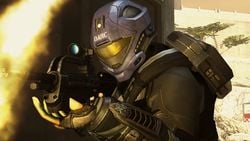
In 2015, the campaign of Halo 3: ODST was brought into Halo: The Master Chief Collection as a standalone expansion, though the game's Firefight mode was noticeably absent. This would remain the status quo for five years, until the release of The Master Chief Collection for PC platforms. On June 10, 2020, a teaser trailer was released by 343 Industries announcing the inclusion of Firefight into the Master Chief Collection to celebrate the Halo 3: ODST's launch on PC. On September 22, the game launched on PC and Firefight was released for PC and Xbox One editions of The Master Chief Collection.[6]
As part of The Master Chief Collection, Firefight has undergone a number of changes inspired by the customisability of the Halo: Reach iteration of Firefight. Notably, Firefight now supports gametype customisation, similar to that of Halo: Reach. Players can alter their player traits and equipment to make themselves more or less vulnerable to enemies, have unlimited ammunition or spawn with any weapon in the ODST sandbox. Notably, this feature now allows players to spawn equipped with a Battle Rifle, a weapon never-before available to use in Halo 3: ODST.[7]
The other primary major change introduced by the expanded Firefight options in The Master Chief Collection is the ability to change the vehicle spawns on the map. This change only affects the map Lost Platoon, as it replaces the default Warthog spawn on the map, but does not add vehicles to any other map. In custom gametypes, players can replace the Lost Platoon Warthog with a Gauss Warthog, Scorpion, Anti-Air Wraith or even a Hornet - the latter two of which have never been available to use prior in the ODST sandbox.[7]
While The Master Chief Collection has these expanded options for Firefight play, the original endless survival experience is still available to play unaltered, now named the FF Classic gametype. For matchmaking play, the standard Firefight gametype performs exactly the same way but ends once one set is completed, and has a thirty minute time limit. Several new gametypes are included by default: Sniperfight, Rocketfight and Fiestafight. The wave options can also be customised, giving players the option of fighting Sentinels and Elites. Specific firefight gametypes that include these new enemies have been added, such as Robocalypse and Elitefight.
In the July 2023 update for The Master Chief Collection, the player cap for ODST Firefight was increased from 4 to 8. The update also introduced the ability to Join-In-Progress and rejoin ongoing games, alongside the addition of Firefight to the Custom Games Browser. The increased player cap did not include any gameplay adjustments to alter the difficulty for new players - it is only intended for use in custom games.[8]
Floodfight[edit]
The April 2022 update for The Master Chief Collection allows players to fight the Flood in Firefight, as part of another new gametype called Floodfight. During Flood waves, maps are shrouded in a dense Flood fog. A variety of Flood enemies have been added, including Combat Forms, Pure Forms and Carrier Forms. A new civilian Human Combat Form has been added, as well as Elite Major Combat Forms. In Floodfight, certain weapons on maps have been changed, such as the addition of the Flamethrower as a power weapon on some maps. This mode also adds the ability for the player's corpse to be infected by the Flood, which produces a brand new ODST Combat Form. Additionally, Aggressor Sentinels may sometimes appear between waves or in a bonus round (and as such, the Sentinel Beam is added to the ODST sandbox). Due to the default setting, the Sentinels often aim for the Flood Combat Forms instead of players. Some maps may receive changes for spawn location, such as Alpha Site where Flood Forms and Sentinels may appear from the elevator. Flood forms are also capable of driving the Warthog on Lost Platoon, becoming a lethal force if not deal with quickly enough. All Flood and Sentinel waves can be selected from regular Firefight options, even mixed with Covenant waves in the same set.
Also in this update, new customization settings have been added to maps in the form of Boons. Boons add helpful assets to the map that players can use, such as additional weapons and allied NPCs which spawn on some maps. Two Spec Ops Elites spawn in drop pods on the night versions of Rally Point and Crater, two Marines spawn on Lost Platoon and Security Zone, and two NMPD Officers spawn on Windward. These allies will respawn each round. Allied Elites can come equipped with Needlers, Plasma Rifles, Carbines, or Fuel Rod Guns, allied Marines spawn with Assault Rifles, Battle Rifles or Shotguns, and allied NMPD Officers spawn with Assault Rifles, Silenced Pistols or Shotguns. These allies can assist the player by manning vehicles or turrets.
Achievements[edit]
Many of Halo 3: ODST's achievements are based in the Firefight mode. Due to The Master Chief Collection's already 700-strong achievement roster, no Firefight-specific achievements were added to the collection, though a number of Firefight-based Challenges were - notably, the Vidmaster Challenge: Endure achievement returned in Series 3: Recon as a challenge.
| Icon (Xbox 360) | Name | Description | Gamerscore |
|---|---|---|---|

|
Be Like Marty | In Firefight, finish a full round without killing a single enemy. | 10 |

|
Firefight: Last Exit | Score over 200,000 points in Firefight on Last Exit. | 10 |

|
Firefight: Chasm Ten | Score over 200,000 points in Firefight on Chasm Ten. | 10 |

|
Firefight: Windward | Score over 200,000 points in Firefight on Windward. | 10 |

|
Firefight: Lost Platoon | Score over 200,000 points in Firefight on Lost Platoon. | 10 |

|
Firefight: Crater | Score over 200,000 points in Firefight on Crater. | 10 |

|
Firefight: Rally Point | Score over 200,000 points in Firefight on Rally Point. | 10 |

|
Firefight: Alpha Site | Score over 200,000 points in Firefight on Alpha Site. | 10 |

|
Firefight: Security Zone | Score over 200,000 points in Firefight on Security Zone. | 10 |

|
Vidmaster Challenge: Endure | In Firefight, on any mission, pass the 4th Set on 4-player Heroic LIVE co-op. | 25 |
Production notes[edit]
- "From day one, when designing campaign missions, we outlined spaces that could work for Firefight. We didn’t have the resources to completely create our own, so they happened inside the missions—which helped the narrative, I think. I’d tell designers what spaces were important, because I had a vision for Firefight that couldn’t be played there and then. We took a massive leap of faith, making environments without Firefight yet existing. It worked out at the end."
- — Paul Bertone on Firefight.[9]
Firefight's origins lie in the wave defence sections encountered throughout the Halo trilogy's campaign levels. In the ViDoc O Brave New World, Lars Bakken credited Firefight's conceptual origins in an encounter on the Halo: Combat Evolved level The Truth and Reconciliation. In the level, the player finds themselves, and their Marine allies, locked in the ship's gravity lift room and forced to fight off numerous waves of Covenant defenders.[10] The idea for a dedicated wave defence mode was later floated during the production of Halo 3, though ultimately did not make the final ship of the game.[11]
During production of Halo 3: ODST, Firefight was internally codenamed "Survival".[8] Halo 3: ODST game director Paul Bertone was responsible for the conception of Firefight as an idea. While developing Halo 3, Bertone worked on the game's campaign scoring mode, which he credits with ultimately leading to Firefight,[9] This, mixed with wave encounters like those from the aforementioned defence segment of The Truth and Reconciliation, ultimately served as the basis for the Firefight mode. Designer Tim Williams ultimately created the first Firefight prototype in-engine, and Martin O'Donnell was instrumental in giving Bertone the push needed to pursue active development of the mode.[9]
Bertone and the other designers on ODST then designed the campaign spaces to serve double-duty as Firefight maps from day one, even before the Firefight mode was functional, due to limited resources available to the small ODST team.[9] Firefight was later detailed in a dedicated ViDoc, Bip. Bap. Bam. Welcome to Firefight.
When porting Firefight into The Master Chief Collection, 343 Industries explored the idea of allowing the Elephant to be useable, so players could bunker down inside the vehicle with multiple turrets. However, this did not work out due to technical reasons - though the developers are still interested in potentially adding this later down the line.[7] While making the Floodfight mode, 343 Industries investigated using the opportunity to resurrect the Flood-infected Arbiter enemies originally intended for inclusion in the Halo 3 level highcharity, though ultimately found the tags had been discarded too early in development to be useable.[12]
Gallery[edit]
Halo 3: ODST[edit]
Halo: The Master Chief Collection[edit]
Four Edward Buck players in ODST Firefight on the Master Chief Collection.
A Flood tank form in Floodfight.
Flood pod infectors attacking players in Floodfight.
An ODST engaging a Flood attacker form in Floodfight.
SpecOps Elites deploying in Firefight on Crater (Night).
Driving an Anti-Aircraft Wraith in Firefight.
Driving a Hornet on Lost Platoon.
Sources[edit]
- ^ a b c Bungie.net, Drop Into Firefight (Retrieved on Oct 12, 2014) [archive]
- ^ Bungie.net, Halo 3: ODST : Features - Firefight (Retrieved on Mar 24, 2013) [archive]
- ^ Halo 3: ODST marketing, Halo 3: ODST ViDoc: Bip. Bap. Bam.
- ^ Bungie.net, Bungie Weekly Update: 08/14/09 (Retrieved on Oct 12, 2014) [archive]
- ^ Bungie.net, Bungie Weekly Update: 09.18.09 (Retrieved on Oct 12, 2019) [archive]
- ^ Halo: The Master Chief Collection marketing, Halo 3: ODST Firefight Teaser
- ^ a b c Halo Waypoint, MCC Development Update - August 2020 (Retrieved on Aug 30, 2020) [archive]
- ^ a b Halo Waypoint, Halo: MCC - July 2023 Update (Retrieved on May 6, 2025) [archive]
- ^ a b c d VICE, The Complete, Untold History of Halo (Retrieved on Jun 1, 2020) [archive]
- ^ Bungie marketing, Bungie ViDoc: O Brave New World: "With Firefight we knew we could take these intense experiences and kind of expand them out into a co-op flavored game type. Firefight really came from the idea of the gravity room in Halo 1. It's where you go up in Truth and Reconciliation into the ship. That room has multiple entrances in, and these Elites start coming to attack you and they come out of different doors. What's it like to be trapped in a place and have to defend it from never-ending enemies that continually get harder? We knew it was going to be big but we didn't know that fans would react to it the way they did, but it was, those were definitely good times." - Lars Bakken
- ^ Co-Optimus, A Look Back: Halo 3: ODST Designed For Co-op (Retrieved on May 9, 2025) [archive]
- ^ Twitter, Dana Jerpak (@The_Psycho_Duck): "The tags for the cut Flood Arbiter are called the "flarbiter". 😁 We looked into resurrecting the flarbiter (pun intended) for Flood Firefight, but it was cut early enough that there was nothing usable." (Retrieved on Mar 29, 2024) [archive]
| |||||||||||
